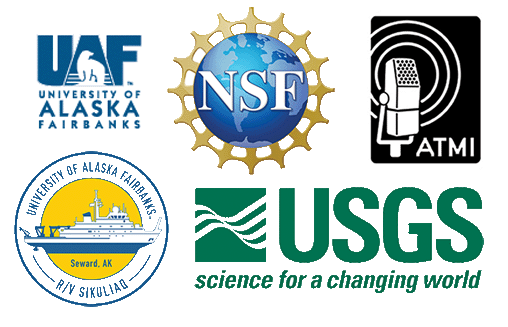What submerged sediments and microfossils can tell us about life on the Bering Land Bridge during the last Ice Age.During the last Ice Age, the Bering Land Bridge was an important migration corridor for plants, animals, and even humans moving between Eurasia and North America. But what was the environment of these lowlands like during the Ice Age? Was it frigid and windy, with only grass and herbs for animals to graze on? Or was it overcast and snowy, with small, woody trees? What happened when the Ice Age ended, the glaciers melted, and the sea level rose? How did the encroaching ocean affect the landscape? Were the coastal waters productive with sea weeds, fish, and marine mammals? How did sea ice affect the amount of rain that fell on nearby land? Meet the Team
The leaders of this project are palynologists, micropaleontologists, sedimentologists, and geophysicists from the University of Alaska Fairbanks (UAF) and the US Geological Survey (USGS). R/V Sikuliaq
Sarah Spanos The research team will sail on the R/V Sikuliaq, an ocean-going research vessel designed to navigate the sometimes-icy waters off the coast of Alaska. The National Science Foundation (NSF) owns the ship and the College of Fisheries and Ocean Sciences at the University of Alaska Fairbanks operates it. The National Science Foundation also funded the cruise and research. 
Beth Caissie, US Geological Survey What will they be doing?Anything in the ocean—grains of sand or pollen, bits of skeletons from fish, tiny single-celled algae, etc.—eventually settles to the sea floor. The sea floor is made up of all these bits of detritus piling up year after year. The top of the sea floor is being deposited today. As you go deeper beneath the sea floor, the layers of sediment get older and older. The same process happens in lakes. The researchers will look for structures in the cores that can tell them whether the sediments were deposited in a lake, on a beach, or beneath the ocean. In addition, they’ll sample the cores and use microscopes to see the tiny pollen grains and fossil algae in the cores. Where are they going?
The planned route is shown by the yellow line. The researchers will be travelling to five basins in the Bering Sea (the blue/yellow blobs on the map). These are places they think were lakes during the last Ice Age when the Bering Land Bridge was exposed. Join us!(all times AK Daylight Time)
Beth Caissie, US Geological Survey Junior Ranger Event
Live-stream From the Ship
Bering Land Bridge National Preserve is excited to support the outreach efforts for this project. We’ll be following the team on their cruise and posting updates. Keep up to date on cruise activities by connecting to the Bering Land Bridge National Preserve social media platforms linked above, reading our blog, or getting daily emails! Email JR Ancheta (jancheta@alaska.edu) to be added to the email list. |
Last updated: August 17, 2023
